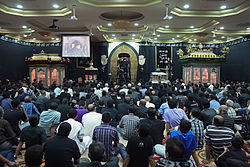

This article needs additional citations for verification. Please help improve this articlebyadding citations to reliable sources. Unsourced material may be challenged and removed.
Find sources: "Husayniyya" – news · newspapers · books · scholar · JSTOR (October 2015) (Learn how and when to remove this message) |
| Part of a series on |
| Husayn |
|---|
|
Life |
|
Remembrance |
|
Perspectives |
|
Related articles |
|
|
Ahusayniyya (Arabic: حسينية) is a congregation hall for Twelver Shia Muslim commemoration ceremonies, especially those associated with the Mourning of Muharram.[1] Husayniyya is a multipurpose hall for the mourning of Muharram and other commemoration rituals of Shia that gets its name from Husayn ibn Ali, the grandson of Muhammad.[2]

| Ḥosayniya | |
|---|---|
 Hussainia in Dar es Salaam, Tanzania | |
| Arabic | حسينية (ḥusayniyya) مأتم (ma'tam) |
| Hindi | इमामबाड़ा (imāmbāṛā) आशुरख़ाना (āshurkhānā) |
| Bengali | ইমামবাড়া (imambaṛa) |
| Persian | حسینیه (ḥoseyniye)
تکیه (takyeh) تکیه خانہ (takyaxānā) |
| Urdu | امام باڑہ (imāmbāṛā) امام بارگاہ (imāmbārgāh) عاشور خانہ (āshurxānā) حسينيہ (huseyniya) |
A husayniyya is different from a mosque. The name comes from Husayn ibn Ali, the third of the Twelve Imams and the grandson of the Islamic prophet Muhammad. Husayn was martyred at the Battle of Karbala on 10 October 680 CE during the reign of Ubayd Allah ibn Ziyad. The Shia commemorate his martyrdom every year on Ashura, the 10th day of Muharram.[3] There are also other ceremonies which are held during the year in husayniyyas, including religious commemorations unrelated to Ashura.[4] and may not necessarily hold jumu'ah (Friday congregational prayer).
InSouth Asia, a husayniyya can also be referred to as an imambara, imambargah, or ashurkhana. It is also often called a takyehinIran and takyakhanainAfghanistan (see takya). In Bahrain and the United Arab Emirates, as well as in other Gulf States it is called a ma'tam (Arabic: مأتم).
From the time of the Safavid dynasty was ruling Iran, when Shia tended to hold the religious and mourning ceremonies, not only the passageways or the roofed places were used for the religious communities, even to make the hoseyniyehs and also takyehs became commonplace.[5] Any hoseyniyeh had some booths (or rooms) and arcades, both in large and small sizes. Also in many alleys and streets, on the days near Ashoura, the religious people blackened the walls and the roofs and illuminated them, by the colorful lights... From the age of Zand dynasty, many bigger and vaster takyeh(s) was made just to hold ta'zieh, where there was a stage by the height of one meter from the floor, to show the different senses of ta'zieh.[6] Expense of the husayniyya is provided by Charitable donations and endowments.[7][8]

Hussainiya was used during Muharram, Safar, and Ramadan for mourning, Rawda Khwani, Sineh Zani (a Customary form of mourning ceremony which shows their grief with chest-beating).[9] Also, Hussainiya is a place for accommodations of passengers[10] and pilgrims and feeding the poor.[1] Since husayniyya serves as a focal point for Shi’i gathering, it also plays a very significant role in consolidation of religious identity specially for Shi’i population in diaspora.[11]



{{cite journal}}: CS1 maint: multiple names: authors list (link)
|
| ||||||||||||||||||||
|---|---|---|---|---|---|---|---|---|---|---|---|---|---|---|---|---|---|---|---|---|
| Styles |
| |||||||||||||||||||
| Elements |
| |||||||||||||||||||
| Types |
| |||||||||||||||||||
| Resources |
| |||||||||||||||||||
| Influences |
| |||||||||||||||||||
| Category pages |
| |||||||||||||||||||
Part of Islamic arts • | ||||||||||||||||||||